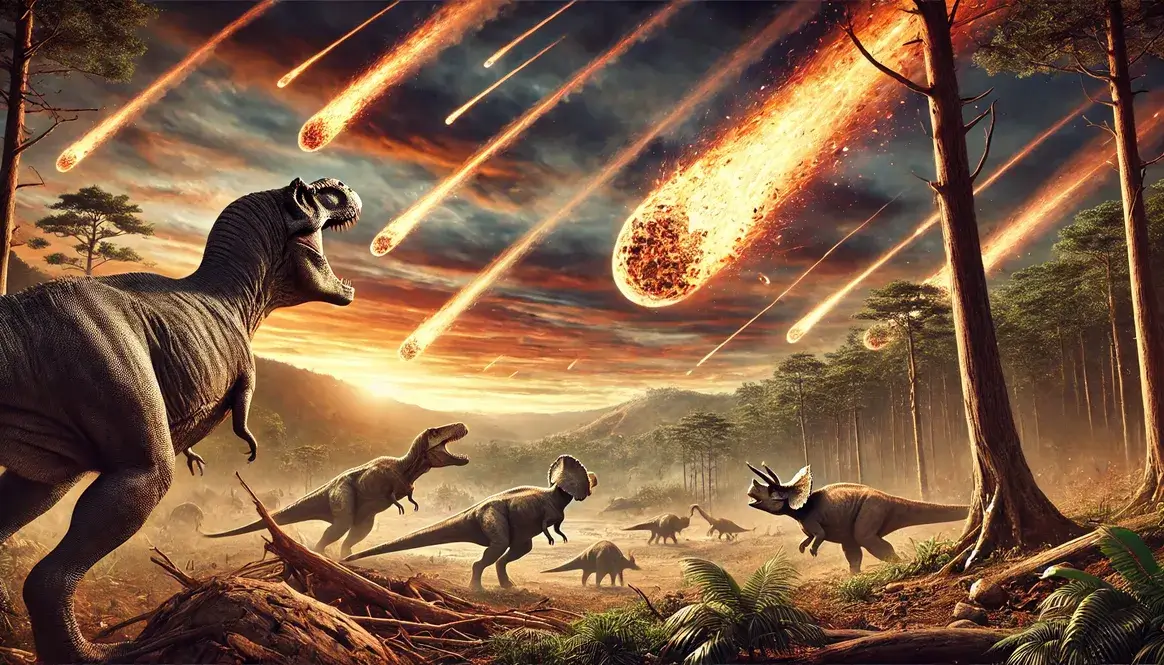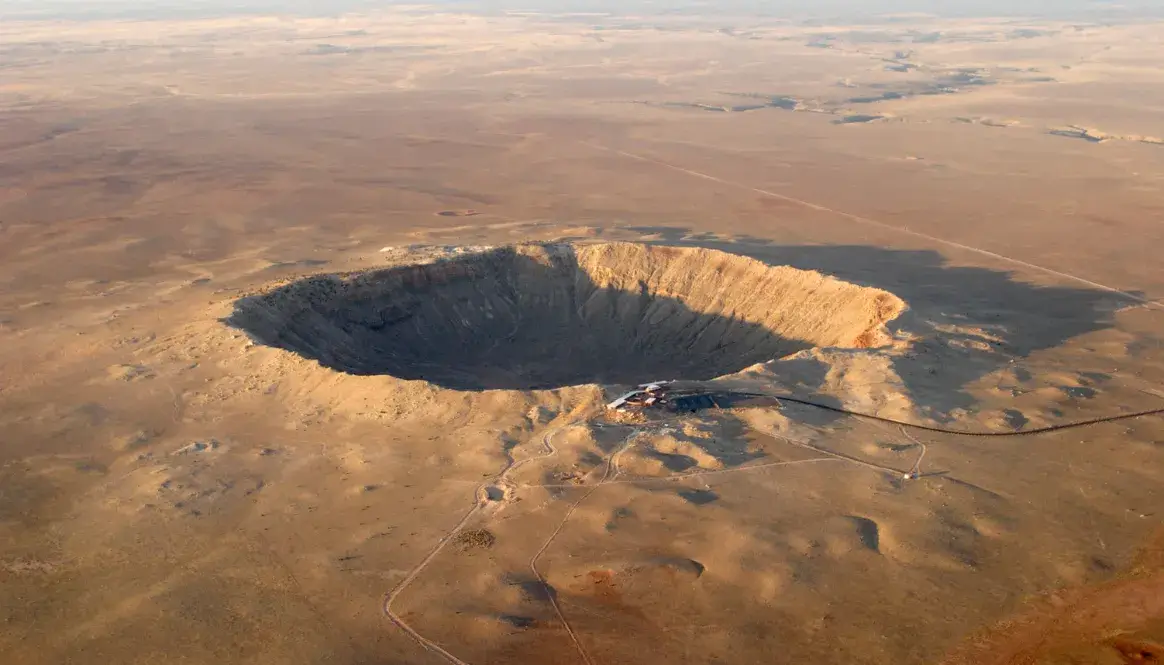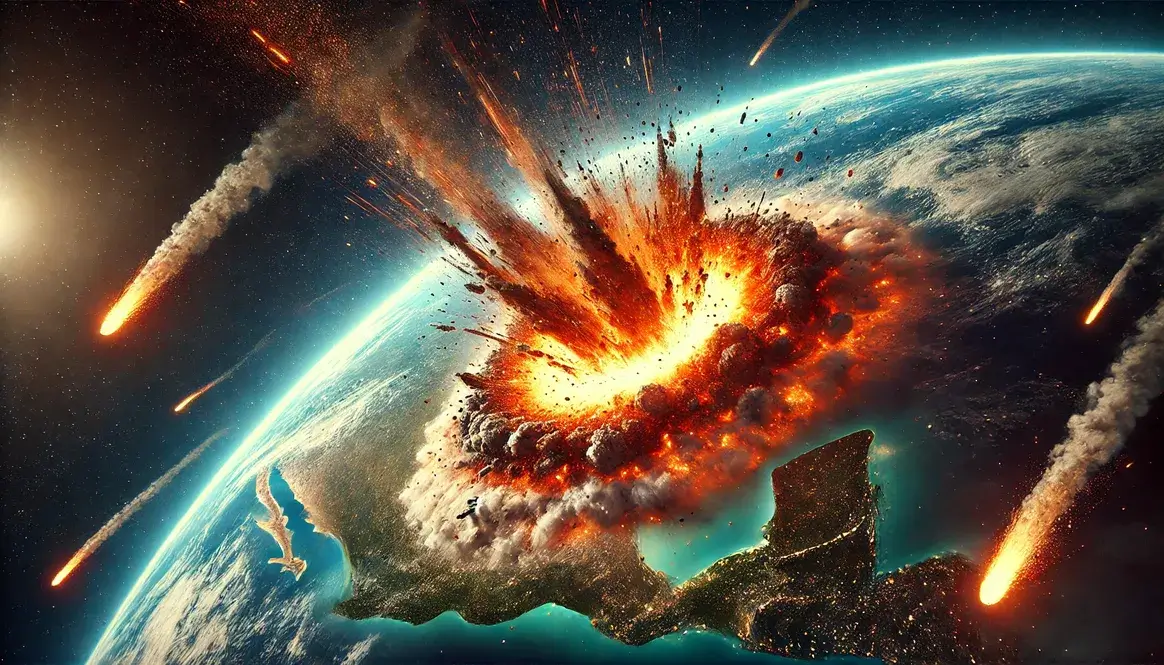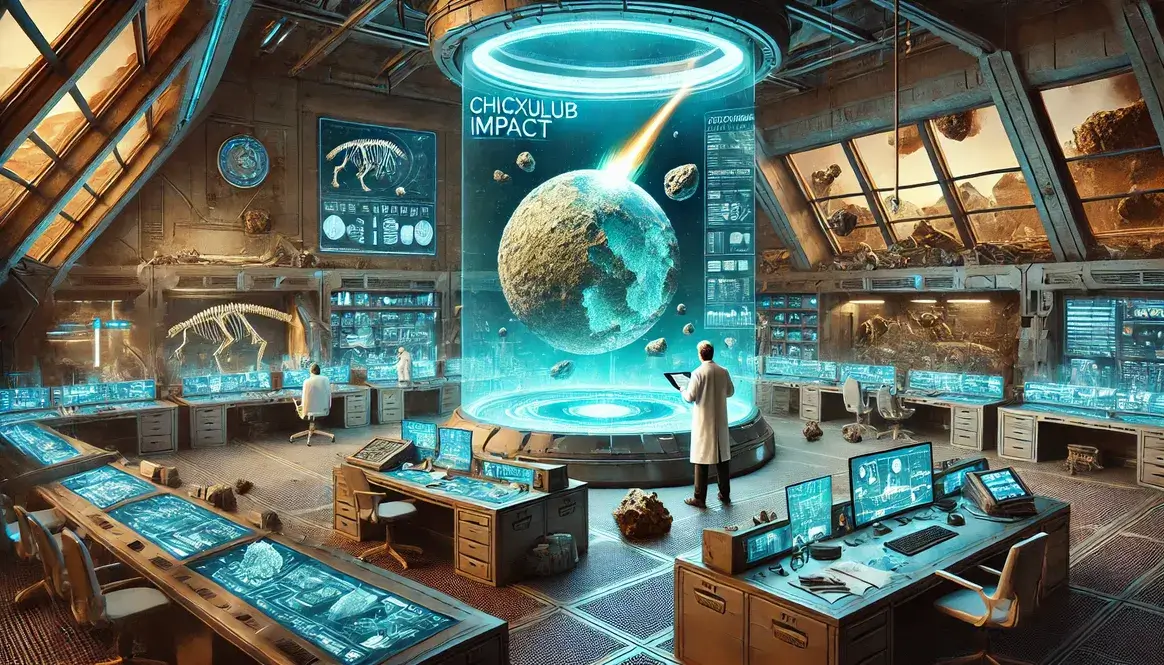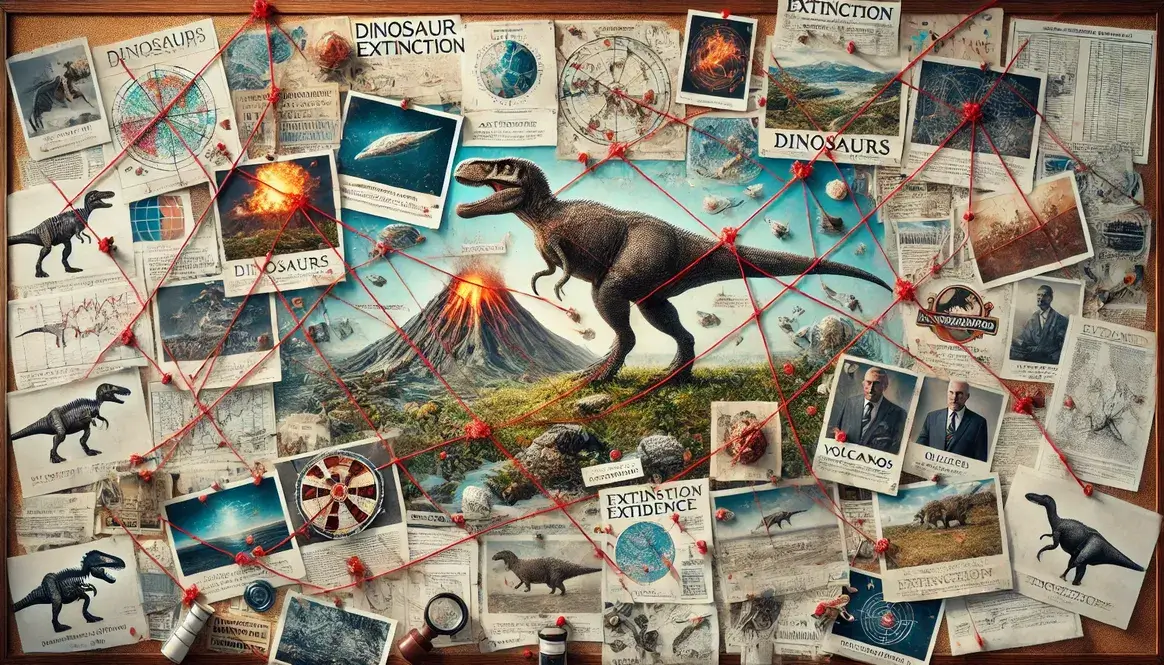When we think about what caused dinosaurs to go extinct, most of us picture a single massive asteroid crashing into Earth. But what if it wasn’t just one space rock that spelled doom for our prehistoric pals? That’s where the multiple impact theory comes in.
This idea suggests that several asteroids might have hit Earth around the same time, working together to cause the mass extinction at the end of the Cretaceous period. It’s like Earth got caught in a cosmic bowling alley, with our planet as the unfortunate pin!
Scientists have been debating this theory for years. Some think it makes sense because it could explain why the extinction was so thorough. Others aren’t so sure, arguing that one big impact was enough to do the job. Let’s dive into the evidence and see what clues we can find about these other possible asteroid culprits.
Other asteroids that killed dinosaurs: Evidence and theories
So, what makes some scientists think there might have been more than one asteroid? It’s all about the craters – those big dents in the Earth’s surface that asteroids leave behind when they hit. Researchers have found several craters that seem to be from around the same time as the famous Chicxulub crater in Mexico, which is linked to the main impact that killed the dinosaurs.
Here’s a quick look at some of the craters that have got scientists talking:
| Crater Name | Location | Estimated Size | Estimated Age |
|---|---|---|---|
| Boltysh | Ukraine | 24 km wide | 65.39 million years |
| Silverpit | North Sea | 2.4 km wide | ~65 million years |
| Shiva | India | 500 km wide | ~65 million years |
As you can see, these craters are all roughly the same age as the extinction event. But let’s focus on one of the most intriguing ones: the Boltysh crater.
The Boltysh crater in Ukraine
Imagine a hole in the ground big enough to fit a small city – that’s the Boltysh crater. Found in Ukraine, this crater is about 24 kilometers (15 miles) wide. Scientists discovered it in the 1960s, but it wasn’t until recently that they realized how important it might be to the dinosaur extinction story.
What makes the Boltysh crater so interesting is its age. Studies show it formed about 65.39 million years ago – that’s just a blink of an eye in geological time after the Chicxulub impact. The K-Pg boundary (previously known as the K-T boundary) marks the end of the Cretaceous period and the beginning of the Paleogene period, right when the dinosaurs went extinct. The Boltysh impact happened right around this time.
So, how might this Ukrainian crater have affected the dinosaurs? Well, if an asteroid big enough to make a 24-kilometer wide crater hit Earth so close to the Chicxulub impact, it could have made the already bad situation even worse. It might have thrown more dust and debris into the atmosphere, cooling the planet even more and making it harder for plants and animals to survive.
But here’s the tricky part: scientists are still trying to figure out if the Boltysh impact happened just before, at the same time as, or shortly after the Chicxulub impact. The timing could make a big difference in how we understand its role in the extinction.
The Silverpit crater in the North Sea
Beneath the waves of the North Sea lies a mysterious underwater structure known as the Silverpit crater. This hidden gem was discovered in 2002 during a routine oil exploration, catching the attention of scientists worldwide.
The Silverpit crater is much smaller than its Ukrainian cousin, measuring only about 2.4 kilometers (1.5 miles) in diameter. But don’t let its size fool you – if it’s truly an impact crater, it could still have played a role in the dinosaur extinction.
However, the origin and age of Silverpit are hot topics of debate among researchers. Here’s why:
- Impact or collapse? Some scientists argue it’s not an impact crater at all, but rather a collapsed underground salt dome.
- Age uncertainty: Dating underwater structures is tricky, and estimates for Silverpit’s age range from 60 to 65 million years old.
- Lack of evidence: The usual signs of an impact, like shocked quartz, haven’t been found at Silverpit.
If Silverpit is indeed an impact crater from around 65 million years ago, it could have contributed to the global chaos following the Chicxulub impact. Even a relatively small asteroid strike might have caused local devastation, potentially triggering tsunamis in ancient seas.
The Shiva crater off the coast of India
Now, let’s journey to the Arabian Sea, where one of the most controversial proposed impact sites lurks beneath the waves. The Shiva crater, named after the Hindu god of destruction, is a geological feature that’s stirred up quite a storm in the scientific community.
The Shiva Controversy
Sankar Chatterjee, a paleontologist from Texas Tech University, proposed the existence of this massive underwater crater in 2009. According to Chatterjee, the Shiva crater is a true behemoth:
- Size: Approximately 500 kilometers (310 miles) in diameter
- Location: Off the west coast of India
- Age: Roughly 65 million years old
If these claims are true, Shiva would be one of the largest impact craters ever discovered on Earth. Its size suggests an asteroid that could have been up to 40 kilometers (25 miles) in diameter – truly a planet-killer!
The Great Debate
However, many geologists remain skeptical about Shiva’s existence as an impact crater. Here’s a quick breakdown of the arguments:
| For Shiva Crater | Against Shiva Crater |
|---|---|
| Presence of shocked quartz | Complex regional geology |
| High iridium levels | Lack of a clear crater structure |
| Potential link to Deccan Traps volcanism | Alternative explanations for geological features |
The scientific community is still divided on whether Shiva is a genuine impact crater or a misinterpretation of complex geological processes. More research and evidence are needed to settle this debate.
Potential Significance
If the Shiva crater is confirmed as a genuine impact site, it would dramatically change our understanding of the end-Cretaceous extinction. An impact of this magnitude could have:
- Intensified global climate disruption
- Triggered massive volcanic eruptions
- Caused widespread tsunamis and earthquakes
The combination of Shiva, Chicxulub, and other potential impacts could explain the severity and suddenness of the mass extinction that wiped out the dinosaurs.
As scientists continue to search for clues about Earth’s impact history, who knows what other cosmic collision sites we might uncover? The story of the dinosaurs’ demise is far from over, and each new discovery brings us closer to understanding this pivotal moment in our planet’s past.
Coordinated asteroid strikes: A cosmic conspiracy?
Have you ever wondered if the universe was playing a game of cosmic billiards with Earth as the target? That’s essentially what the theory of coordinated asteroid strikes suggests. This idea proposes that multiple asteroids hit our planet within a short time span, working together to cause the mass extinction that ended the reign of the dinosaurs.
But how could several space rocks decide to bombard Earth all at once? It’s not like they held a meeting and planned an attack! The answer might lie in the break-up of a larger celestial body. Imagine a giant asteroid or comet falling apart as it traveled through space. The resulting fragments could have rained down on Earth over a relatively short period, creating multiple impact sites.
This scenario could explain why we find several impact craters dating back to around the same time as the famous Chicxulub impact. It’s like Earth got caught in a cosmic crossfire!
The Oort cloud hypothesis
To understand where these asteroids might have come from, we need to take a trip to the outskirts of our solar system. Way out there, far beyond the planets, lies a vast collection of icy bodies known as the Oort cloud.
The Oort cloud hypothesis suggests that disturbances in this distant region could send a flurry of comets and asteroids hurtling towards the inner solar system. Here’s how it might work:
- A passing star or other gravitational influence disturbs the Oort cloud
- This disturbance dislodges numerous icy bodies
- Some of these objects are sent on a collision course with Earth
Scientists believe this process could lead to periods of increased impact activity on Earth, potentially lasting thousands or even millions of years. It’s like shaking a cosmic snow globe, with Earth unfortunately in the path of the falling “snowflakes”!
The scientific basis for this theory lies in our understanding of celestial mechanics and the structure of the solar system. Astronomical observations and computer models support the idea that external forces can indeed influence the Oort cloud, potentially triggering these impact events.
Asteroid showers in Earth’s history
But is there any evidence that Earth has experienced these asteroid showers before? As it turns out, our planet’s geological record might hold some clues.
Impact Clusters
Researchers have identified several periods in Earth’s history when impact events seem to have occurred more frequently. These “impact clusters” suggest that our planet has indeed experienced asteroid showers in the past.
Here’s a look at some notable impact clusters:
| Time Period | Notable Impacts |
|---|---|
| 470 million years ago | Multiple impacts during the Ordovician Period |
| 200 million years ago | Several craters linked to the Triassic-Jurassic extinction |
| 35-40 million years ago | A series of impacts in the late Eocene |
End-Cretaceous Connection
So, how does this relate to the extinction of the dinosaurs? The multiple impact theory suggests that the end-Cretaceous extinction might have been caused by one of these asteroid showers. The Chicxulub impact could have been the largest in a series of strikes that battered the Earth, each adding to the global environmental catastrophe.
This scenario could explain why the extinction was so severe and affected such a wide range of species. Multiple impacts occurring over thousands or even millions of years would have put immense stress on global ecosystems, making it increasingly difficult for life to adapt and survive.
While the evidence for an asteroid shower at the end of the Cretaceous is still debated, the idea continues to intrigue scientists. As we uncover more impact craters and refine our dating techniques, we may gain a clearer picture of whether Earth was indeed subjected to a cosmic barrage that spelled doom for the dinosaurs.
Scientific debates: One impact or many?
The question of whether one or multiple impacts caused the dinosaur extinction continues to spark lively debates in the scientific community. While the Chicxulub impact remains the primary suspect, the multiple impact hypothesis has gained traction in recent years.
Currently, most scientists agree that the Chicxulub impact played a crucial role in the mass extinction. However, there’s growing interest in the possibility that other impacts may have contributed to the global catastrophe. Let’s break down the arguments on both sides:
Arguments for a single impact:
- The Chicxulub crater’s size and timing align perfectly with the extinction event
- Global evidence of impact-related materials at the K-Pg boundary
- Simplicity: One large impact is sufficient to explain the extinction
Arguments for multiple impacts:
- Discovery of other impact craters dating to the same period
- Potential for prolonged environmental stress from multiple strikes
- Explanation for the severity and global nature of the extinction
Challenges to the multiple impact theory
While intriguing, the multiple impact theory faces several hurdles:
- Dating Dilemmas: Precisely dating impact craters is like trying to hit a moving target. Here’s why:
- Erosion and geological processes can alter crater features
- Radiometric dating has margins of error that can span millions of years
- Contamination from surrounding rocks can skew results
- Crater Confusion: Not every circular depression is an impact crater. Some challenges include:
- Distinguishing between impact craters and volcanic calderas
- Identifying submarine craters, which can be masked by sediment
- Differentiating impact structures from other geological formations
These factors make it difficult to definitively link multiple craters to the same extinction event. Critics argue that without precise dating and clear impact evidence, the multiple impact theory remains speculative.
Support for multiple impacts
Despite these challenges, some scientists continue to champion the multiple impact hypothesis. Their work provides intriguing evidence and raises important questions about Earth’s impact history.
Key supporters and studies:
- Dr. Gerta Keller (Princeton University)
- Argues for multiple impacts based on geological evidence
- Suggests the Chicxulub impact predates the K-Pg boundary
- The Boltysh crater research team
- Dated the Ukrainian crater to shortly after the K-Pg boundary
- Proposes it may have prolonged post-Chicxulub environmental stress
- Sankar Chatterjee (Texas Tech University)
- Advocates for the controversial Shiva crater hypothesis
- Suggests a series of major impacts caused the extinction
These researchers believe that multiple impacts could better explain the pattern of extinction and environmental changes observed in the fossil record. They argue that a series of impacts over thousands or even millions of years could have caused:
- Prolonged global cooling
- Repeated disruptions to the food chain
- Cumulative stress on ecosystems worldwide
If proven, the multiple impact hypothesis could revolutionize our understanding of mass extinctions. It might suggest that cosmic bombardments play a more significant role in shaping Earth’s evolutionary history than previously thought. This could have implications for how we view other extinction events and even for assessing future impact risks.
As the debate continues, new discoveries and advanced dating techniques may help resolve the question of whether Earth faced one mighty blow or a cosmic onslaught at the end of the Cretaceous. Until then, the mystery of dinosaur extinction remains a captivating area of scientific inquiry.
Implications of multiple impacts
If the multiple impact hypothesis is correct, it could dramatically change our understanding of how the dinosaurs met their end. Let’s explore how a series of asteroid strikes might have affected our planet and its inhabitants.
Imagine Earth as a boxer in the ring. A single, powerful punch (like the Chicxulub impact) can certainly knock you down. But what if that punch was followed by a flurry of smaller hits? Even if none of these additional blows were as strong as the first, they could prevent the boxer from getting back up. This scenario might help explain why the end-Cretaceous extinction was so thorough and affected such a wide range of species.
Here’s how multiple impacts could have turned Earth into a very unfriendly place for dinosaurs:
- Global cooling on steroids: Each impact would have thrown dust and aerosols into the atmosphere, blocking sunlight. While a single impact might cause a brief “impact winter,” multiple strikes could prolong and intensify this cooling effect. Plants would struggle to photosynthesize, leading to widespread ecosystem collapse.
- Yo-yo climate: Between impacts, the climate might start to recover, only to be plunged back into chaos by the next strike. These rapid swings could be even more devastating than a single, prolonged change, as organisms wouldn’t have time to adapt.
- Acid rain overdrive: Impacts release sulfur and nitrogen compounds into the atmosphere. With multiple impacts, acid rain could increase, damaging plants and acidifying water bodies. This would further stress terrestrial and aquatic ecosystems.
- Firestorms and more: Each impact could trigger widespread fires, releasing more carbon dioxide and particulates into the atmosphere. The cumulative effect might be global firestorms that would dramatically alter landscapes and atmospheric composition.
The potential for prolonged environmental stress on dinosaurs in this scenario is significant. Instead of facing a single, harsh blow, they would have encountered a series of environmental challenges over an extended period. This could explain why some groups of dinosaurs seem to have declined gradually before the final extinction event.
Consider this timeline:
| Time | Event | Effect on Dinosaurs |
|---|---|---|
| Initial impact | Chicxulub asteroid strikes | Immediate devastation in impact zone, global climate disruption |
| +100 years | Secondary impact (e.g., Boltysh) | Renewed climate chaos, further ecosystem stress |
| +1000 years | Tertiary impact | Prolonged environmental instability, cumulative stress on surviving populations |
| +10,000 years | Continued smaller impacts | Preventing ecosystem recovery, gradual decline of remaining species |
In this scenario, even dinosaurs that initially survived the Chicxulub impact would face ongoing challenges. Food sources would become increasingly scarce as plant communities struggled to recover between impacts. Herbivorous dinosaurs would be hit first, followed by the carnivores that depended on them.
Moreover, the constant environmental flux could have favored smaller, more adaptable species. This might help explain why some groups, like early mammals and birds, managed to survive while the larger dinosaurs perished.
While this multiple impact scenario is still hypothetical, it offers a compelling explanation for the severity and duration of the end-Cretaceous extinction. As scientists continue to uncover evidence of ancient impact events, we may gain a clearer picture of how cosmic collisions shaped the course of life on Earth.

